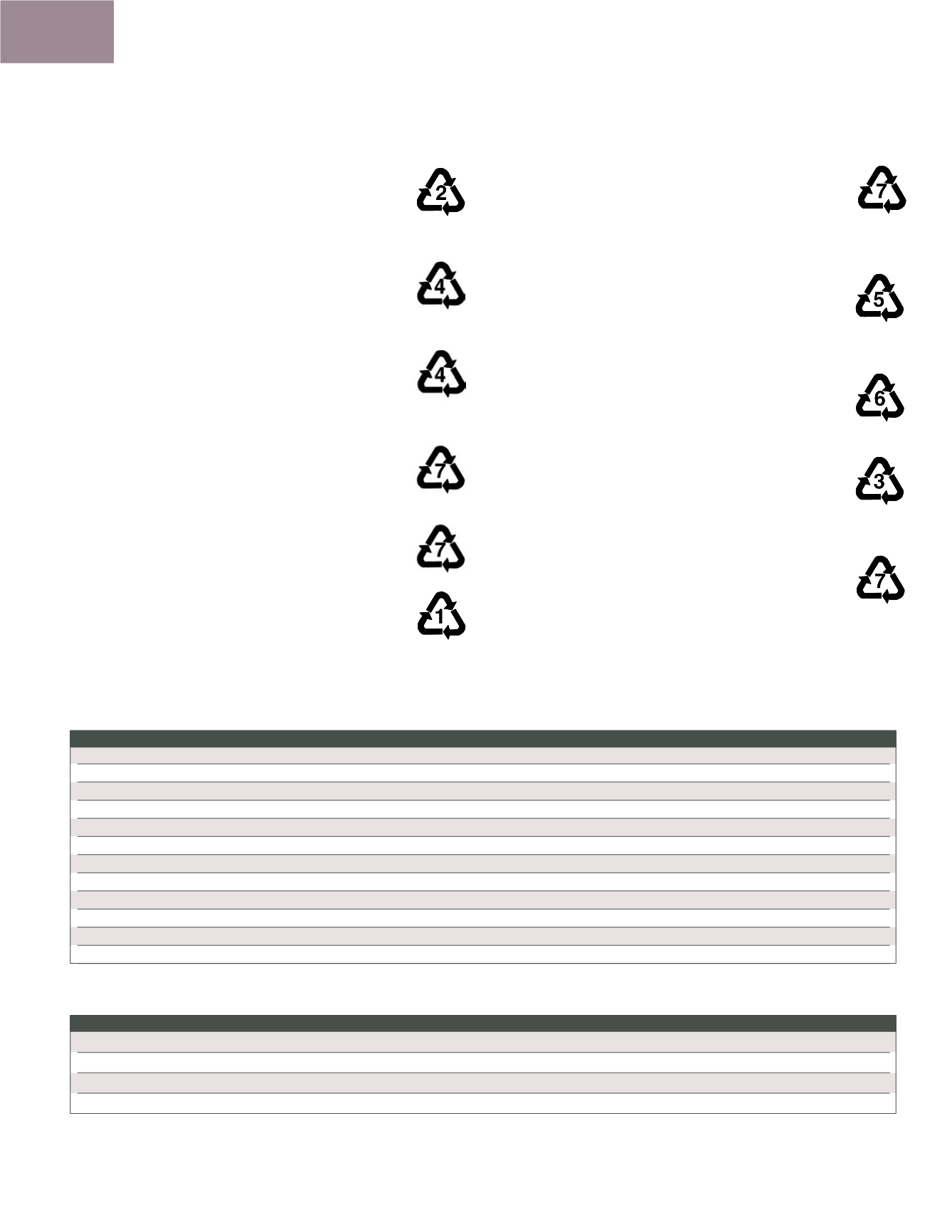

WHEATON
800.225.1437 (U.S. & Canada Only) | 856.825.1100 | 856.825.1368 (F) |
www.wheaton.comHigh Density Polyethylene (HDPE)
Flexible but more rigid than LDPE. Natural color is milky white, semi-
translucent depending on density. Good impact strength and stress crack
resistance. Good chemical resistance. Good vapor barrier but poor gas
barrier. Sterilizable via EtO or gamma radiation.
Low Density Polyethylene (LDPE)
Very flexible, natural milky color, translucent with high impact strength.
Excellent for mild and strong buffers, good chemical resistance. Good water
vapor and alcohol barrier properties. Poor gas barrier, sterilizable with EtO
or gamma radiation. Good stress crack and impact resistance.
Linear Low Density Polyethylene (LLDPE)
Very flexible, natural milky color, translucent with high impact strength.
Excellent for mild and strong buffers, good chemical resistance. Good water
vapor and alcohol barrier properties. Poor gas barrier, sterilizable with EtO
or gamma radiation. Good stress crack and impact resistance.
Polybutylene Terephthalate (PBT)
Good chemical resistance, clear color, resistant to water, weak acids and
bases at room temperature. Can be sterilized by EtO and autoclaving, at
temperatures up to 180°C.
Polycarbonate (PC)
Rigid and strong, excellent clarity. High impact strength. Poor barrier
properties.
Polyethylene Terephthalate (PET)
Semi-rigid to rigid depending on wall thickness. Natural color — clear and
transparent. Good alcohol and solvent barrier; good gas and fair moisture
barrier. Good to fair chemical barrier; not good for strong acids or bases.
Good moldability. Sterilizable through EtO and gamma radiation. Good
stress crack and impact resistance at room temperature and above.
Table 8. Typical Properties of Plastics
HDPE
LDPE
LLDPE
PC
PET
PETG
PP
PS
PVC
PTFE
Max. Temp °C
120
80
50
135
60
70
135
70
70
240
Transparency
Transl
Transl
Transl
Transp
Transp
Transp
Transl
Transp
Transl
Opaq
Sterilization**
Autoclave
No
No
No
Yes
No
No
Yes
No
No
Yes
Gas
Yes
Yes
Yes
Yes
Yes
Yes
Yes
Yes
Yes
Yes
Dry Heat
No
No
No
No
No
No
No
No
No
Yes
Radiation
Yes
Yes
Yes
Yes
Yes
Yes
No
Yes
No
No
Disinfectants
Yes
Yes
Yes
Yes
Yes
Yes
Yes
No
Yes
Yes
Density G/Cm
3
0.95
0.92
0.92
1.19
1.33
1.27
0.90
1.06
1.34
2.15
Flexibility
Semi
Flex
Flex
Rigid
Semi
Semi
Rigid
Rigid
Rigid
Rigid
Brittleness Temp °C
-100
-100
-76
-135
-10
-40
0
+20
-30
-110
Tensile Strength, Psi
4000
2400
2000
9000
8000
7500
5000
6000
5000
4000
**Depends on thickness and relates to containers and closures. Because there are many grades of resins and processing methods, the above information should be used as a general guideline only.
Table 9. Permeability of Plastics
HDPE
LDPE
LLDPE
PC
PET
PETG
PP
PS
PVC
PTFE
N
2
See Note 1
42
180
—
50
0.8
10
44
50
2
—
O
2
See Note 1
150
500
—
250
5
25
90-140
185-485
4
—
CO
2
See Note 1
580
2700
— 1000
15
125
650
1160
4
—
Moisture
See Note 2
0.3
1.3
—
7.4
2.0-4.0
0.5
0.3-0.7
8.5
1.0-5.0
—
Note 1: Units are cc x mil / 100 in
2
x day x atm @ 25°C
Note 2: Units are g x mil / 100 in
2
x day @ 38°C, 50 - 90% RH
Polyethylene Terephthalate Glycol (PETG)
Semi-rigid to rigid depending on wall thickness. Natural color — clear and
transparent. Good alcohol and solvent barrier; fair gas and good moisture
barrier. Good to fair chemical barrier; not good for strong acids or bases.
Good moldability. Sterilizable through EtO and gamma radiation. Good
stress crack and impact resistance at room temperature and above.
Polypropylene (PP)
Rigid, solid, durable in container or closure forms. Opaque, natural grayish
yellow in natural form. Excellent stress crack and impact resistance.
Excellent moisture barrier, good oil and alcohol barrier, poor gas barrier
properties. Good chemical resistance. Sterilizable with EtO or autoclaving.
Polystyrene (PS)
PS is a transparent, rigid and glass-like polymer. Good resistance to
inorganic chemicals. Light and heat stable, biologically inert and non-toxic.
Poor impact and stress crack resistance, poor barrier properties. EtO or
Gamma sterilizable.
Polyvinyl Chloride (PVC)
Flexible to rigid. Good for coatings; fair water and good oxygen barrier.
Transparent to yellowish color in natural state. Good chemical resistance.
Sterilizable by EtO. Good impact and some stress crack resistance. Poor
recycling due to chloride residues.
PTFE, FEP, PFA
Polytetraflouroethylene, fluorinated ethylene propylene, perfluoralkoxy.
All fluoropolymers feature opaque characteristics, excellent chemical
resistance, good heat stability and thermal shock resistance. All are
autoclavable, heat, and gas sterilizable.
> 183
Technical Data, Plastic
Plastic Resins
Listed below are the primary resins used in the manufacture of our products. Following are some of the characteristics and features of these resins. Also listed is the Society of the Plastic
Industry (SPI) resin identification code number.
















